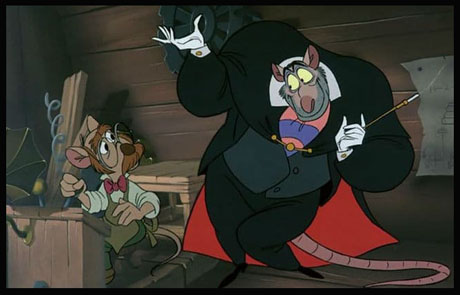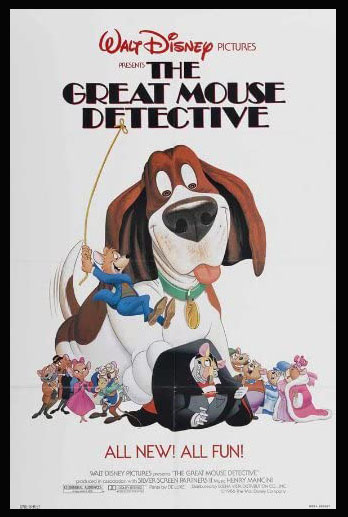
While it was in production, The Great Mouse Detective was like a “wallflower,” just waiting for a dance.
The film was developed at Disney in the ’80s, a time of significant change at the studio. Michael Eisner had just joined the company as CEO, with Jeffrey Katzenberg coming on board with him, taking charge of Disney’s motion picture division.
Several film projects were underway at this time as the new leadership team settled in. One was a troubled production called The Black Cauldron, which generated a tremendous amount of attention as the new leadership team at Disney, unfamiliar with animation, grappled to understand better how to best smoothly and effectively complete the film.

While all eyes focused on this epic, fantasy adventure, an alternative, smaller animated film, entitled Basil of Baker Street, was concurrently being worked on, just waiting for someone to notice it. In 1982, Ron Clements, who would co-direct the film with someone who would become his longtime directing partner John Musker and studio veterans Dave Michener and Burny Mattinson, proposed adapting the series of Basil of Baker Street books by author Eve Titus.
When Eisner and Katzenberg came on board, they screened an early “story reel” of the film and gave it the “green light,” under the new title, The Great Mouse Detective. The renaming of the film resulted in a now-infamous “joke memo” that was circulated at the studio, renaming all of Disney’s classic films (ex: Snow White and the Seven Dwarfs became Seven Little Men Help a Girl).
With a budget of $10 million (as compared to The Black Cauldron’s $25 million, which had grown to $44 million during production), The Great Mouse Detective would be a decidedly modest film. Set in London in 1897, it would tell the tale of Basil (voiced by Barrie Ingham), a mouse who lives in the home of Sherlock Holmes and emulates the famed human sleuth. He partners with Dr. Dawson (Val Bettin, as a mouse version of Dr. Watson) to find kidnapped toymaker Hiram Flaversham (Alan Young, who had provided the voice of Scrooge McDuck in Mickey’s Christmas Carol just a few years prior).
It’s discovered that Flaversham had been kidnapped by the nefarious Professor Ratigan (a rat version of Sherlock Homes’ nemesis, Professor Moriarity), who plans to use the toymaker’s skills to overthrow the Queen.

The voice of Ratigan was a major casting coup, in that Disney secured one of film’s most recognizable voices with horror movie icon Vincent Price. This perfect voice was partnered with the artistry of master animator Glen Keane, who would serve as the supervising animator for Ratigan.
In the book, The Disney Villain by animation legends Frank Thomas and Ollie Johnston, Keane revealed that he created a “backstory” to bring more depth to Ratigan. Keane said: “‘I wrote a history of Basil as a child and Ratigan as a child. What kind of kid was Ratigan? Why did he end up going this path? What was it like at home for him? In animating it, it just felt like you were spending some time with this guy – you weren’t just plopping down at this point in history as if there never had been years before.’”
In addition to Price, another legendary Hollywood name was part of The Great Mouse Detective, composer Henry Mancini, who had created innumerable famous film scores, including “The Pink Panther Theme” (1963) and “Moon River” from Breakfast at Tiffany’s (1961).
Mancini not only wrote the score for The Great Mouse Detective but also contributed two songs, “The World’s Greatest Criminal Mind” and “Goodbye So Soon.”

Another song in The Great Mouse Detective, “Let Me Be Good to You,” was written and performed by pop singer Melissa Manchester (who plays the role of pub singer Miss Kitty Mouse in the film). Eisner had initially wanted either Michael Jackson or Madonna to lend their voices to the film for this musical number.
The Great Mouse Detective would also break new ground and begin to point animation toward its future with its use of computer-generated imagery. Computer animation was used to create the gears and mechanisms inside Big Ben, the setting for the film’s impressive concluding chase between Basil and Ratigan.
The CGI was incorporated with the hand-drawn animation of the characters. It provided the filmmakers the ability to emulate a live-action movie in how they staged the sequence and seemingly “moved” the camera in a groundbreaking moment for Disney.
The scene was noted by many critics when they reviewed The Great Mouse Detective, released on July 2, 1986. Many stated that the film was a standout, not just compared to Disney’s most recent animated features but also other studio’s animated offerings at the time.
New York Newsday’s Joseph Gelmis called it “…a meticulously crafted, good-natured cartoon adventure…”
The Great Mouse Detective was released on the precipice of a renaissance at Disney, which would give the world films like The Little Mermaid (1989), Beauty and the Beast (1991), and The Lion King (1994).
Thirty-five years after its debut, the film stands as an example of a studio breaking free of the shackles of disappointing decades. This was noted by animation historian and author Charles Solomon when reviewing the film for its 1992 re-release in the Los Angeles Times. He wrote:
“The Great Mouse Detective reflects the energy and enthusiasm of a talented group of young artists stretching their wings for the first time. That group has gone on to produce some truly extraordinary work, win awards, and earn sums no one believed could be made from an animated film. And, as has often been the case at Disney, it all began with a mouse.”
- An Eye for A Classic: The 60th Anniversary of “Mr. Magoo’s Christmas Carol” - December 22, 2022
- A Very Merry Mickey: The 70th Anniversary of “Pluto’s Christmas Tree” - December 19, 2022
- A Fine French Feline Film: The 60th Anniversary of “Gay Pur-ee” - December 12, 2022


 July 14th, 2021
July 14th, 2021  Michael Lyons
Michael Lyons  Posted in
Posted in  Tags:
Tags: 






